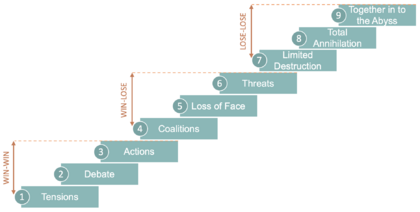MBTI in Conflict Management
Written by Anna Hessellund Diedrichsen
Contents |
Abstract
The article provides an examination of the application and benefits of MBTI in conflict management relevant to project management. Conflicts are inevitable between stakeholders defined as individuals who affect or are affected by a decision, activity or output of project management according to Project Management Institute [1]. Conflict management is crucial to foster healthy conflicts to improve effectiveness and productivity. An application of Myers–Briggs Type Indicator(MBTI) provides insights about differences in perception and judgement of all team members , valuable to determine appropriate behaviour, communication style and conflict management style when conflicts occur [2].
Firstly, the concept of MBTI is emphasised explaining the 16 personality types and four preferences, Extraversion vs. Introversion, Sensing vs. Intuition, Thinking vs Feeling and Judging vs. Perceiving, which combined assesses the way an individual prefer to perceive information and make decisions. Secondly, the article defends the application of MBTI in conflict management by emphasising the MBTI personality preferences linkage to the core activities in managing conflicts.
Lastly, limitations of MBTI are discussed. Concerns about feasibility, flexibility, reliability are questioning. The project manager’s interpretation and assessment of an individual must not be limited to the MBTI type.
Conflict Management
From a pluralist viewpoint organisations consist of stakeholders having different values and goals where conflicts can be constructive. Conflict management is as the process of which the PM identifies and handles conflicts and is crucial to create effectiveness and productivity, further justified and elaborated by S.G. Daugaard [3]. Conflict management is the art of empathizing differences of interests, preferences, and approaches to maximise performance and productivity of an organisation hence. It is a practice that involves activities related to such as identification of arising conflict, cause of conflict, and how to mitigate and solve it [4]. Conflicts inevitable arise due to 10 causes in the process of developing team effectiveness, and are products of numerous variables leading to arguments between people competing personal interests. The most significant conflict causes are following[5];
- Disagreements escalating
- Poor organisational structure
- Personality clashes / differences in values & goals
- Poor communication
The purpose of conflict management is to foster healthy conflicts in a team. Further, F. Glasl’s model explains the nine stages of conflict escalation and it is of interest to identify and solve a conflict in the earlier stages to ensure win-win result between parties [6]. Thereby, conflicts can be positive and proactive however affect all stakeholders, hence it is relevant to understand individual personalities and interactions across team members in conflict management.

Myers–Briggs Type Indicator (MBTI)
The purpose of Myers-Briggs Type Indicator tool is to support project management in delivering output effectively within deadline. This article validates the application of MBTI in conflict management.
The Concept
The invention of Myers–Briggs Type Indicator assessment by Katharine Cook Briggs and Isabel Briggs Myers originates from the theory described by C. G. Jung about analytical psychology[7] . MBTI provides an examination of the individual’s conscious feelings and thoughts with the purpose of emphasizing differentiation in the way people perceive information and make decisions. Hence, MBTI discusses the individual’s preferences and not capabilities. It is the world’s most universally and widely used assessment tool to understand the individual's preferences and determine type. To clarify it is not a personality test but a typing test. Cite error: Closing </ref> missing for <ref> tag
[1]
Cite error:
<ref> tags exist, but no <references/> tag was found